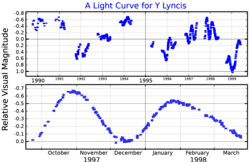Y Lyncis
 A visual band light curve for Y Lyncis, adapted from Percy et al. (2001).[1] The top panel shows the brightness variation over a period of several years, and the lower panel shows shorter time scale variations. | |
| Observation data Epoch J2000 Equinox J2000 | |
|---|---|
| Constellation | Lynx |
| Right ascension | 07h 28m 11.61657s[2] |
| Declination | +45° 59′ 26.2295″[2] |
| Apparent magnitude (V) | 6.2 - 8.9[3] |
| Characteristics | |
| Spectral type | M6S Ib[4] |
| Variable type | SRc[4] |
| Astrometry | |
| Radial velocity (Rv) | 5.50±0.6[5] km/s |
| Proper motion (μ) | RA: −1.278[2] mas/yr Dec.: −4.067[2] mas/yr |
| Parallax (π) | 2.8068 ± 0.1138 mas[2] |
| Distance | 1,160 ± 50 ly (360 ± 10 pc) |
| Details | |
| Mass | 1.5 - 2.0[3] M☉ |
| Radius | 580[3] R☉ |
| Luminosity | 10,765[6] L☉ |
| Surface gravity (log g) | 0.0[7] cgs |
| Temperature | 3,200[7] K |
| Metallicity [Fe/H] | −0.19[7] dex |
| Other designations | |
| Database references | |
| SIMBAD | data |
Y Lyncis is a semiregular variable star in the constellation Lynx. It is an asymptotic giant branch star of spectral type M6S, with a luminosity class of Ib, indicating a supergiant luminosity. It is around 1,160 light years away. Y Lyncis ranges in brightness from magnitude 6.2 to 8.9. When it is at its brightest, it very faintly visible to the naked eye under excellent observing conditions.
In 1901 it was announced that Williamina Fleming had discovered that the star, then known as BD +46°1271, is a variable star.[8] It was given its variable star designation, Y Lyncis, in 1912.[9] The changes in brightness of this star are complex, with at least two different periods showing. The General Catalogue of Variable Stars lists a period of 110 days.[10] More recent studies show a primary pulsation period of 133 days, with and a long secondary period with an amplitude of 0.2 magnitudes and duration 1,300 days. The long secondary period variations are possibly caused by long-lived convection cells.[11]
Y Lyncis has a mass around 1.5-2.0 M☉ and a luminosity around 10,000 L☉. It is a thermally pulsing asymptotic giant branch star, an evolved star with a carbon-oxygen core that is fusing helium in a shell and hydrogen in a separate shell.[12] It is also an S-type star, where third dredge-ups have brought some carbon to the surface, but not enough to create a carbon star.[6]
References
- ^ Percy, John R.; Wilson, Joseph B..; Henry, Gregory W. (August 2001). "Long-Term VRI Photometry of Small-Amplitude Red Variables. I. Light Curves and Periods". Publications of the Astronomical Society of the Pacific. 113 (786): 983–996. Bibcode:2001PASP..113..983P. doi:10.1086/322153. S2CID 14609175.
- ^ a b c d e Vallenari, A.; et al. (Gaia collaboration) (2023). "Gaia Data Release 3. Summary of the content and survey properties". Astronomy and Astrophysics. 674: A1. arXiv:2208.00211. Bibcode:2023A&A...674A...1G. doi:10.1051/0004-6361/202243940. S2CID 244398875. Gaia DR3 record for this source at VizieR.
- ^ a b c Szatmary, Karoly; Vinko, Jozsef (1992). "Periodicities of the light curve of the semiregular variable star Y Lyncis". Monthly Notices of the Royal Astronomical Society. 256 (2): 321–28. Bibcode:1992MNRAS.256..321S. doi:10.1093/mnras/256.2.321.
- ^ a b Kiss, L. L.; Szabó, Gy. M.; Bedding, T. R. (2006). "Variability in red supergiant stars: Pulsations, long secondary periods and convection noise". Monthly Notices of the Royal Astronomical Society. 372 (4): 1721–1734. arXiv:astro-ph/0608438. Bibcode:2006MNRAS.372.1721K. doi:10.1111/j.1365-2966.2006.10973.x. S2CID 5203133.
- ^ Gontcharov, G. A. (November 2006). "Pulkovo Compilation of Radial Velocities for 35,495 Hipparcos stars in a common system". Astronomy Letters. 32 (11): 759–771. arXiv:1606.08053. Bibcode:2006AstL...32..759G. doi:10.1134/S1063773706110065. eISSN 1562-6873. ISSN 1063-7737. S2CID 119231169.
- ^ a b Guandalini, R.; Busso, M. (2008). "Infrared photometry and evolution of mass-losing AGB stars. II. Luminosity and colors of MS and S stars". Astronomy and Astrophysics. 488 (2): 675–684. arXiv:0806.4591. Bibcode:2008A&A...488..675G. doi:10.1051/0004-6361:200809932. S2CID 14294870.
- ^ a b c Soubiran, Caroline; Le Campion, Jean-François; Brouillet, Nathalie; Chemin, Laurent (2016). "The PASTEL catalogue: 2016 version". Astronomy & Astrophysics. 591: A118. arXiv:1605.07384. Bibcode:2016A&A...591A.118S. doi:10.1051/0004-6361/201628497. S2CID 119258214.
- ^ Pickering, E. C.; Colson, H. R.; Fleming, W. P.; Wells, L. D. (April 1901). "Sixty-four new variable stars". Astrophysical Journal. 13: 226–230. Bibcode:1901ApJ....13..226P. doi:10.1086/140808. Retrieved 23 December 2024.
- ^ Dunér; Hartwig; Müller (June 1912). "Benennung von neu entdeckten veränderlichen Sternen". Astronomische Nachrichten. 191 (19): 341–358. Bibcode:1912AN....191..341.. doi:10.1002/asna.19121911902. Retrieved 23 December 2024.
- ^ Samus, N. N.; Durlevich, O. V.; et al. (2009). "VizieR Online Data Catalog: General Catalogue of Variable Stars (Samus+ 2007-2013)". VizieR On-line Data Catalog: B/GCVS. Originally Published in: 2009yCat....102025S. 1. Bibcode:2009yCat....102025S.
- ^ Percy, John R.; Sato, Hiromitsu (2009). "Long Secondary Periods in Pulsating Red Supergiant Stars". Journal of the Royal Astronomical Society of Canada. 103 (1): 11. Bibcode:2009JRASC.103...11P.
- ^ Guandalini, R.; Busso, M. (2008). "Infrared photometry and evolution of mass-losing AGB stars". Astronomy and Astrophysics. 488 (2): 675–684. arXiv:0806.4591. Bibcode:2008A&A...488..675G. doi:10.1051/0004-6361:200809932. S2CID 14294870.
